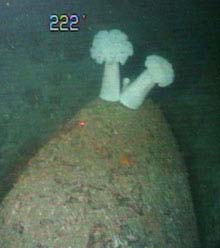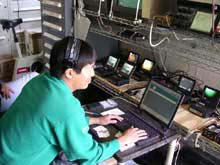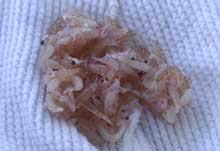
White-plumed anemone (Metridium giganteum) as viewed from the ROV video camera on the ocean bottom at a depth of 70 meters. Click image for larger view.
Wrapping Up
Gulf of the Farallones Sanctuary Quest Mission Leg
May 25, 2002
Paul Wong, Education Specialist
Gulf of the Farallones National Marine Sanctuary
After four days in the Gulf of the Farallones the McArthur finished this leg of the Sanctuary Quest research cruise. Originally scheduled for ten days, this portion of the cruise was cut short due to the delay caused by the ship fire and repair of equipment.
Even with the limited ship time in the Gulf of the Farallones, the science team was able to gather valuable information to add to the long-term Ecosystem Dynamics Study.
This comprehensive research monitors ocean conditions such as temperature, conductivity, and depth, samples and quantifies relative amounts of chlorophyll and plankton, and correlates observations of seabirds and marine mammals at known locations in the Gulf of the Farallones. Additionally, ROV dives provided opportunities to get a glimpse of bottom habitats and associated marine life.

Data manager Paul Wong records notations on the bottom habitat and observed species while viewing the digital video from the cameras mounted on the ROV. Click image for larger view.
The cruise was a unique opportunity for the science team to cover much of the Gulf of the Farallones and see the diversity of marine life that makes it such a dynamic place. The McArthur crisscrossed the Gulf of the Farallones numerous times to take advantage of ocean conditions and research opportunities.
During times when the ROV was being repaired or conditions were too rough for a dive the science team took advantage by performing wildlife observation transects. One transect on the first day took the McArthur from the relatively calm and shallow waters of Drake's Bay near Point Reyes out past the Farallon Islands to the deep waters off the continental shelf. It was incredible to see the Farallon Islands and the coastline along Point Reyes in the glow of the setting sun.
While the major upwelling season and its corresponding productivity occur in the coming summer months, the ocean waters are still full of marine life.

A handful of krill that was removed from one of the ships engine filters. Click image for larger view.
There was plenty of evidence of krill around as humpback whales and seabirds were observed on the surface feeding and the plankton nets were also full of the small shrimp-like crustaceans. This abundance also affected the ship's operation. At the last sampling station of the cruise, a surface swarm of krill was seen breaking the water near the boat. Shortly thereafter the ship's engineer responded to an alarm in the engine room and found that one of the filters was plugged with krill. He reported that it was the third time he had cleaned krill off the filters.
Having completed research in the Gulf of the Farallones National Marine Sanctuary, the McArthur is scheduled to head out next to Cordell Bank National Marine Sanctuary for ten days.

























